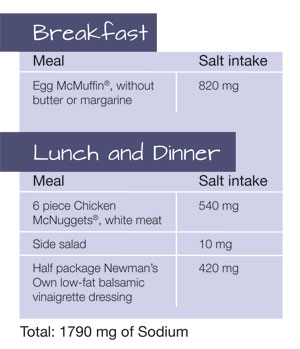
As fast food restaurants continue to create “healthier” food choices on their menus, have you considered their definition of “healthy?” If they increased the amount of sodium, is it really healthier?
A study published in The New England Journal of Medicine found that reducing salt intake by about 3 grams a day would significantly improve our health, reducing cases of chronic heart disease, stroke, and heart attack by about one-third. It would also save up to $24 billion in annual healthcare costs.
McDonald’s recently launched a new campaign, McDonald’s Real Life Choices, which shows consumers how to order from its menu, and keep track of calories, carbohydrates, and fat. According to the Mayo Clinic, the recommendation of sodium per day for a 4- to 8-year-old child is 1,200 milligrams per day and 1,500 milligrams for a 9- to 13-year-old. How does the “healthier” menu stack up?

These options may provide fewer calories and less sodium than a Big Mac, but “healthy”? That’s pushing it. We still need to consider the overall health factor of fast food. The closer we can get to the farm, and take in fresh produce, the healthier our bodies will be. While fast food chains attempt to “market” parents into believing they are feeding their kids healthy foods, the fact is lower calories doesn’t always equal healthier; and the reality is that fast food places are still home to unhealthy processed foods that are leading to many health concerns in this country. So if you’re looking for healthier choices at a fast food restaurant, be sure to be armed with your own definition of healthy before you order.






